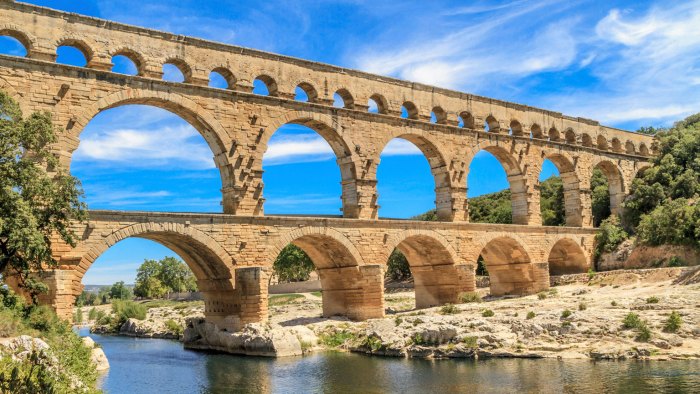The diffusion of aqueduct technology occurred because of which development? This intriguing question takes us on a journey through the annals of human ingenuity, where engineering advancements, political and economic factors, environmental conditions, and cultural exchange converge to shape the remarkable spread of aqueducts.
From the towering arches of ancient Rome to the subterranean marvels of modern metropolises, aqueducts have played a pivotal role in the development of civilizations, providing access to clean water and sanitation, fostering economic growth, and shaping urban landscapes. Understanding the factors that drove the diffusion of this transformative technology sheds light on the interconnectedness of human endeavors and the enduring impact of infrastructure on society.
The Diffusion of Aqueduct Technology

The diffusion of aqueduct technology was driven by a confluence of engineering advancements, political and economic factors, environmental conditions, and cultural exchange. These factors interacted to enable the construction and spread of aqueducts, revolutionizing water management and sanitation practices in ancient civilizations.
Engineering Advancements
The construction of aqueducts required significant engineering prowess. Ancient engineers developed innovative techniques and materials to build durable and efficient structures. They employed arched construction, hydraulic engineering principles, and specialized tools to create aqueducts that could transport water over long distances and challenging terrains.
The Pont du Gard in France, a Roman aqueduct built in the 1st century CE, is a testament to the remarkable engineering achievements of the time.
Political and Economic Factors
The development and spread of aqueducts were closely tied to political power and economic resources. Empires and governments played a pivotal role in funding and organizing the construction of aqueducts, recognizing their strategic importance for urban sanitation, military operations, and economic prosperity.
Wealthy individuals and private companies also invested in aqueducts, seeking to capitalize on the demand for clean water and the potential for profit.
Environmental Conditions
Environmental factors played a crucial role in shaping the design and construction of aqueducts. The availability of water sources, topography, and climate influenced the choice of routes, materials, and engineering techniques. Aqueducts were often built to tap into natural springs or rivers, and their paths were carefully planned to navigate obstacles such as mountains and valleys.
The Roman aqueduct system in North Africa, for instance, showcased the adaptation of aqueduct technology to arid environments.
Cultural Exchange and Diffusion, The diffusion of aqueduct technology occurred because of which development
Cultural exchange and diffusion facilitated the spread of aqueduct technology across civilizations. Trade, travel, and military conquests allowed for the transfer of knowledge and skills related to aqueduct construction. The Roman Empire played a particularly significant role in disseminating aqueduct technology throughout its vast territories.
By adopting and adapting aqueduct designs from other cultures, civilizations such as the Greeks and Persians contributed to the evolution and diffusion of this essential technology.
FAQ Overview: The Diffusion Of Aqueduct Technology Occurred Because Of Which Development
What were the primary engineering advancements that enabled the construction of aqueducts?
Engineering advancements included the development of surveying techniques, the use of arches and vaults for structural support, and the invention of waterwheels for lifting water.
How did political and economic factors contribute to the diffusion of aqueduct technology?
Political power and economic resources played a crucial role in the construction and maintenance of aqueducts, with empires, governments, and wealthy individuals often sponsoring these projects.
What environmental conditions influenced the spread of aqueducts?
Environmental factors such as the availability of water sources, topography, and climate shaped the design and construction of aqueducts, influencing their efficiency and longevity.


